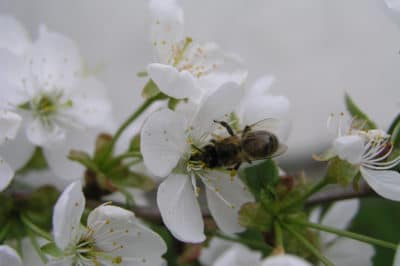Pollinated Flowers Lead to Fruit on Sweet and Sour Cherries
Without flowers, a cherry tree would not produce fruit because it is the act of pollination within the flower which forms the fruit.
Some varieties of cherry tree are what is known as self-fertile, meaning they have the reproductive structures for flowers to pollinate themselves. Other varieties need the pollen from a different cherry variety for successful pollination.
Many varieties of sweet cherry cannot pollinate themselves and need the help of a different type of cherry to form fruit. This is called self-unfruitful.
Self-unfruitful varieties include:
- Bing
- Royal Ann
- Lambert
- Van
- Black Tartarian
Other sweet cherry varieties are self-fruitful, but fruit set is still better with cross-pollination. These types can provide pollen for self-unfruitful trees:
- Black Gold
- Lapins
- Sweetheart
- White Gold
- Sunburst
- Symphony
- Stella
However, in order for this cross-pollination to be successful, both trees must flower at the same time, and not all varieties are compatible.
If your cherry tree flowers but does not produce a crop of fruit, it may not have the right cross-pollinator nearby.
Sour cherry varieties are usually self-fertile and do not need to be planted with a compatible pollinator tree, and they cannot pollinate sweet cherry trees.
The Fragrance of Cherry Blossoms
In spite of their beauty, many types of edible cherry tree have flowers with little to no fragrance. However, several varieties of cherry blossom trees, which don’t produce edible fruit, do have fragrant flowers.
Among the most fragrant are the Japanese flowering cherries, Prunus amanogawa, Prunus shirofugan, Prunus shirotae, and several Yoshino cherry varieties.
Other Facts about Cherry Blossoms
Cherry blossoms are edible, but they do contain the substance coumarin, which is toxic if consumed in large amounts. The flowers and leaves of cherry trees both have culinary uses in Japan. The essence from blossoms is used in certain confections, and a drink called sakuraya is made with pickled blossoms and consumed on special occasions.
Japanese culture places a high value on the enchanting and ephemeral blossom of cherry trees, which are called sakura in Japanese. Annual cherry blossom festivals in Japan are celebrated with picnics under the trees, along with musical performances and painting pictures of the blooms.
It was a gift from the Mayor of Tokyo in 1912 of 3,000 flowering cherry trees which began the annual Cherry Blossom festival in Washington D.C., celebrated every April since.
